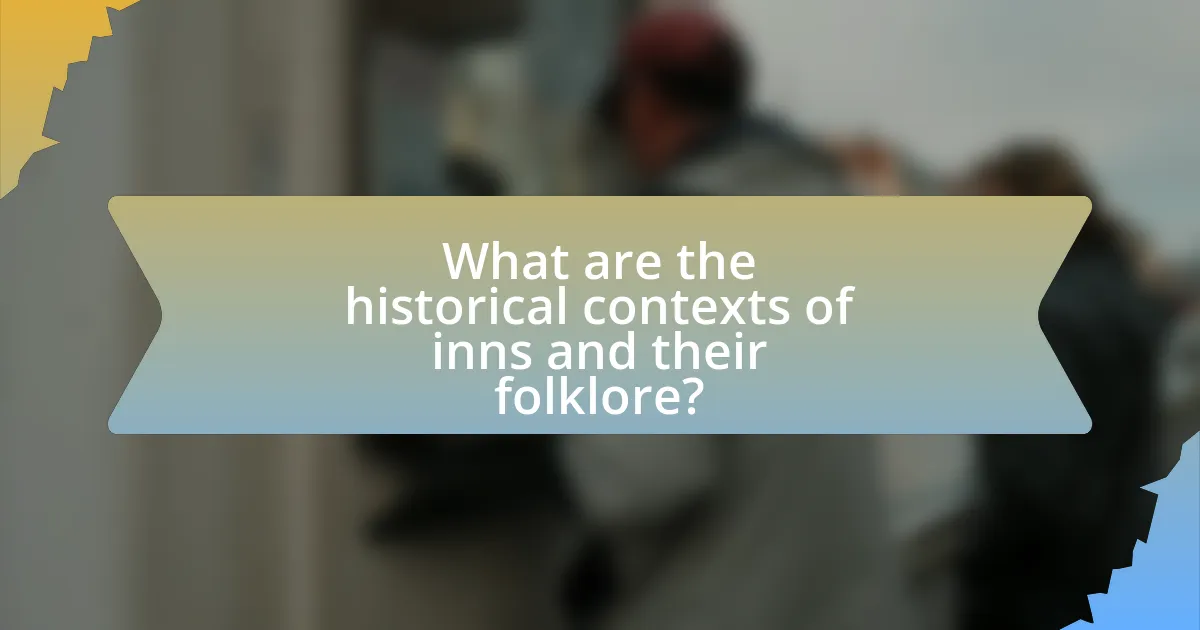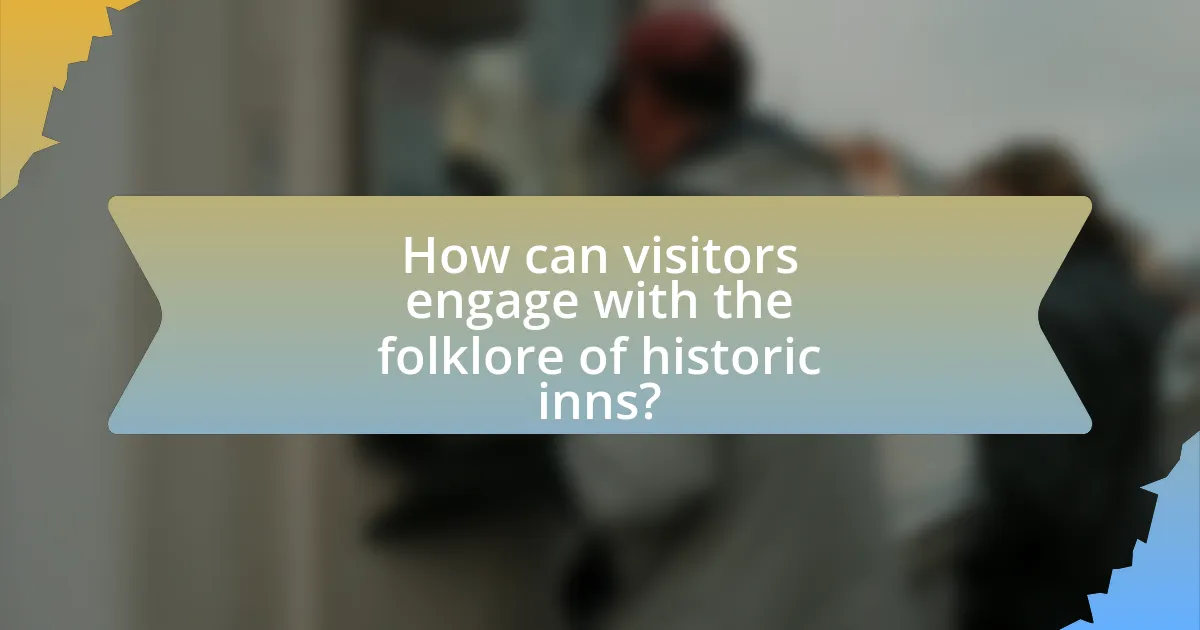Historic inns are significant cultural landmarks that serve as repositories of local folklore, intertwining historical narratives with regional legends. These establishments, often dating back centuries, preserve and share stories related to notable figures, ghost tales, and significant events, enhancing the guest experience and fostering community identity. The architectural features of these inns reflect local heritage, while storytelling events and guided tours provide immersive opportunities for visitors to engage with the folklore. Overall, historic inns play a crucial role in preserving cultural heritage and promoting tourism through their unique connections to local narratives.

What is the Connection Between Historic Inns and Local Folklore?
Historic inns often serve as repositories of local folklore, as they are frequently associated with historical events, notable figures, and regional legends. These establishments, some dating back centuries, have hosted travelers and locals alike, allowing stories and traditions to be shared and preserved over time. For example, many historic inns are linked to ghost stories or tales of famous visitors, which contribute to the cultural identity of the area. The presence of these narratives enhances the guest experience, as visitors are drawn to the unique history and character of the inns, making them integral to the local folklore.
How do historic inns serve as repositories of local folklore?
Historic inns serve as repositories of local folklore by preserving and sharing the stories, traditions, and cultural narratives of their communities. These establishments often have deep historical roots, dating back to significant events or periods, which allows them to embody the local heritage. For example, many historic inns display artifacts, host storytelling events, and provide literature that highlights regional legends and myths, thereby fostering a connection between guests and the local culture. Additionally, the oral histories shared by innkeepers and staff contribute to the living tradition of folklore, making these inns vital centers for cultural exchange and preservation.
What types of folklore are commonly associated with historic inns?
Historic inns are commonly associated with ghost stories, legends of hauntings, and local myths. These types of folklore often arise from the inns’ long histories, where tales of past guests or significant events contribute to their reputations. For example, many historic inns have documented ghost sightings or unexplained phenomena, which attract visitors seeking paranormal experiences. Additionally, local legends may involve famous figures who stayed at these inns, further embedding them in the cultural narrative of the area. Such folklore not only enhances the charm of these establishments but also serves as a means of preserving local history and traditions.
How do the architectural features of historic inns reflect local stories?
The architectural features of historic inns reflect local stories by incorporating design elements that symbolize cultural heritage and historical events. For instance, inns built in colonial styles often showcase features such as wide verandas and steep roofs, which are indicative of the region’s climate and social practices. These structures frequently include local materials, such as stone or timber, that tell the story of the area’s natural resources and craftsmanship. Additionally, decorative motifs and murals may depict significant local legends or historical figures, serving as visual narratives that connect the inn to the community’s identity. This integration of local stories into architectural design not only preserves history but also fosters a sense of belonging among residents and visitors alike.
Why is the connection between historic inns and folklore significant?
The connection between historic inns and folklore is significant because it serves as a cultural repository that preserves local traditions and narratives. Historic inns often act as gathering places where stories are shared, thus fostering community identity and continuity. For example, many inns are associated with specific legends or historical events, such as the tales of ghostly apparitions or notable figures who stayed there, which enhances their appeal and cultural relevance. This intertwining of folklore with the physical space of inns not only enriches the visitor experience but also contributes to the local economy through tourism, as travelers seek authentic cultural experiences tied to the history of the area.
What role do historic inns play in preserving cultural heritage?
Historic inns serve as vital custodians of cultural heritage by preserving architectural styles, local traditions, and historical narratives. These establishments often reflect the unique characteristics of their regions, showcasing traditional building techniques and materials that are emblematic of local craftsmanship. For instance, many historic inns feature period furnishings and decor that tell the story of the community’s past, allowing visitors to experience the cultural context in which they were built. Furthermore, historic inns frequently host events that celebrate local folklore, traditions, and cuisine, thereby fostering a deeper connection between guests and the cultural identity of the area. This role is underscored by the fact that many historic inns are listed on national registers of historic places, which helps protect them and promote awareness of their significance in preserving local heritage.
How does folklore enhance the visitor experience at historic inns?
Folklore enhances the visitor experience at historic inns by providing a rich narrative context that deepens engagement with the location. Visitors often seek immersive experiences, and folklore offers stories that connect them to the history and culture of the area, making their stay more memorable. For instance, tales of local legends or ghost stories associated with a specific inn can create a unique atmosphere, encouraging guests to explore the surroundings and participate in themed events. Research indicates that storytelling can significantly increase visitor satisfaction, as it fosters a sense of belonging and connection to the place.

What are the historical contexts of inns and their folklore?
Inns have historically served as essential waypoints for travelers, providing shelter, food, and social interaction since ancient times. The establishment of inns can be traced back to the Roman Empire, where they were known as “mansiones,” facilitating trade and travel along roads. Over centuries, inns evolved into local hubs, often associated with folklore that reflects the cultural narratives of their regions. For example, many inns became the settings for ghost stories and legends, such as the tales surrounding the Old Bell Inn in Derbyshire, England, which is reputed to be haunted by a former innkeeper. These stories often served to attract visitors and preserve local history, intertwining the identity of the inn with the community’s folklore. The historical significance of inns is further underscored by their roles in significant events, such as the American Revolution, where inns often hosted meetings and discussions among revolutionaries. Thus, the historical contexts of inns are deeply embedded in the social and cultural fabric of their locales, with folklore serving as a narrative vehicle that enhances their historical importance.
How have historic inns evolved over time?
Historic inns have evolved from simple lodging establishments catering to travelers into multifaceted venues that often incorporate local culture and history. Initially, these inns provided basic shelter and meals for weary travelers, often reflecting the architectural styles and social customs of their time. Over the centuries, as tourism grew, many historic inns transformed into destinations themselves, offering unique experiences that highlight local folklore, cuisine, and traditions. For example, inns in regions with rich histories, such as New England, often feature stories and themes related to local legends, enhancing their appeal to visitors seeking authentic cultural experiences. This evolution is evidenced by the preservation of historic buildings and the integration of storytelling into the hospitality experience, which has become a significant aspect of their operation.
What historical events have influenced the folklore surrounding inns?
Historical events such as the establishment of trade routes, the rise of the coaching inn system in the 17th and 18th centuries, and significant wars have influenced the folklore surrounding inns. The establishment of trade routes facilitated the movement of travelers, leading to the creation of inns as essential rest stops, which in turn gave rise to stories of ghostly encounters and local legends tied to these locations. The coaching inn system, which provided lodging for travelers and their horses, became a backdrop for tales of highwaymen and romantic escapades, enriching the folklore. Additionally, events like the English Civil War and the Jacobite risings contributed to the lore, as inns often served as meeting points for rebels and soldiers, leading to stories of hauntings and hidden treasures associated with these historical figures.
How do different regions showcase unique folklore in their inns?
Different regions showcase unique folklore in their inns through themed decor, storytelling events, and local cuisine that reflect cultural narratives. For example, inns in New England often feature ghost stories and maritime legends, while Southern inns may highlight tales of local folklore, such as those surrounding the Civil War or Native American history. This integration of folklore is evident in the design elements, such as murals or artifacts that depict local legends, and in organized events like storytelling nights that invite guests to engage with the region’s history. Such practices not only enhance the guest experience but also preserve and promote the cultural heritage of the area.
What are some famous historic inns known for their folklore?
Some famous historic inns known for their folklore include the White Horse Inn in England, which is reputed to be haunted by the ghost of a former innkeeper, and the Stanley Hotel in Colorado, famous for its connection to Stephen King’s “The Shining” and its own ghost stories. The White Horse Inn dates back to the 15th century and has numerous tales of spectral sightings, while the Stanley Hotel, built in 1909, has a rich history of paranormal activity, including reports of ghostly children playing in the halls. These inns not only provide lodging but also serve as cultural landmarks steeped in local legends and ghost stories, attracting visitors interested in both history and the supernatural.
What stories are associated with these renowned inns?
Renowned inns are often associated with various stories that reflect local folklore and history. For example, the White Horse Inn in England is linked to tales of ghostly apparitions and historical figures, including the legendary highwayman Dick Turpin, who is said to have frequented the establishment. Similarly, the Olde Bell Inn in Berkshire is known for its connections to the English Civil War, where it served as a meeting place for soldiers and has stories of hidden passages used during that time. These narratives not only enhance the character of the inns but also serve as a means of preserving local history and culture.
How do these inns attract visitors through their folklore?
Historic inns attract visitors through their folklore by leveraging unique local legends and stories that enhance the guest experience. These narratives often include tales of historical events, ghost stories, or notable figures associated with the inn, creating an immersive atmosphere that appeals to tourists seeking authenticity. For instance, inns may host themed events or guided tours that highlight these stories, thereby increasing engagement and interest. Additionally, the incorporation of folklore into marketing materials, such as brochures and websites, emphasizes the inn’s distinctive character and cultural significance, drawing in visitors who are intrigued by the local heritage.

How can visitors engage with the folklore of historic inns?
Visitors can engage with the folklore of historic inns by participating in guided tours that highlight local legends and stories associated with the inn. These tours often include storytelling sessions led by knowledgeable guides who share historical anecdotes and folklore that enrich the visitor experience. For instance, many historic inns have documented ghost stories or tales of notable guests, which can be found in local archives or through the inn’s own historical records. Engaging with interactive exhibits or attending themed events, such as folklore festivals, also allows visitors to immerse themselves in the cultural narratives tied to the inn’s history.
What activities can visitors participate in to learn about local folklore?
Visitors can participate in guided storytelling sessions to learn about local folklore. These sessions often take place in historic inns, where storytellers share tales rooted in the region’s history and culture, providing context and depth to the narratives. Additionally, visitors can engage in folklore workshops that may include traditional crafts, music, or dance, allowing them to experience the cultural practices associated with the stories. Many historic inns also host themed events or festivals that celebrate local legends, offering immersive experiences that highlight the significance of folklore in the community.
How do guided tours enhance understanding of folklore at historic inns?
Guided tours enhance understanding of folklore at historic inns by providing curated narratives that connect guests with local traditions and stories. These tours often include knowledgeable guides who share specific folklore related to the inn’s history, architecture, and the surrounding area, thereby contextualizing the tales within the physical space. For example, a guided tour might recount ghost stories tied to a particular room or highlight local legends that have been passed down through generations, making the folklore more relatable and engaging. This immersive experience allows visitors to appreciate the cultural significance of the folklore, as they can visualize and connect with the stories in the very locations where they originated.
What role do storytelling events play in connecting visitors with folklore?
Storytelling events serve as a vital link between visitors and folklore by immersing audiences in cultural narratives that reflect local traditions and history. These events facilitate engagement through oral traditions, allowing visitors to experience folklore in an interactive manner. For instance, storytelling sessions often feature local tales that highlight historical events, regional myths, and community values, thereby fostering a deeper understanding of the cultural context. Research indicates that such immersive experiences enhance visitors’ emotional connections to the folklore, making it more memorable and impactful.
What tips can enhance the experience of exploring folklore at historic inns?
To enhance the experience of exploring folklore at historic inns, engage with local storytellers and participate in guided tours that focus on the inn’s history and surrounding legends. These interactions provide authentic insights into the cultural narratives tied to the location. Additionally, reading local folklore literature or historical accounts before your visit can deepen your understanding and appreciation of the stories shared. Research indicates that immersive experiences, such as themed events or folklore nights hosted by the inns, can significantly enrich visitors’ connections to the local culture and history.
How can visitors research local folklore before their visit?
Visitors can research local folklore before their visit by utilizing online resources, visiting local libraries, and engaging with community organizations. Online platforms such as folklore databases, regional history websites, and social media groups dedicated to local culture provide accessible information. Local libraries often house archives, books, and oral histories that detail regional folklore. Additionally, community organizations, such as historical societies or cultural centers, frequently host events or provide materials that highlight local legends and stories, offering firsthand insights into the folklore of the area.
What should visitors look for in historic inns to appreciate their folklore?
Visitors should look for unique architectural features, historical artifacts, and storytelling opportunities in historic inns to appreciate their folklore. Architectural elements, such as period-specific designs and materials, often reflect the cultural heritage of the area, providing insight into local traditions. Historical artifacts, including photographs, furniture, and documents, can offer tangible connections to the past, enriching the understanding of regional stories and legends. Additionally, engaging with innkeepers or participating in guided tours can reveal oral histories and folklore that are integral to the inn’s identity, enhancing the overall experience of the visitor.